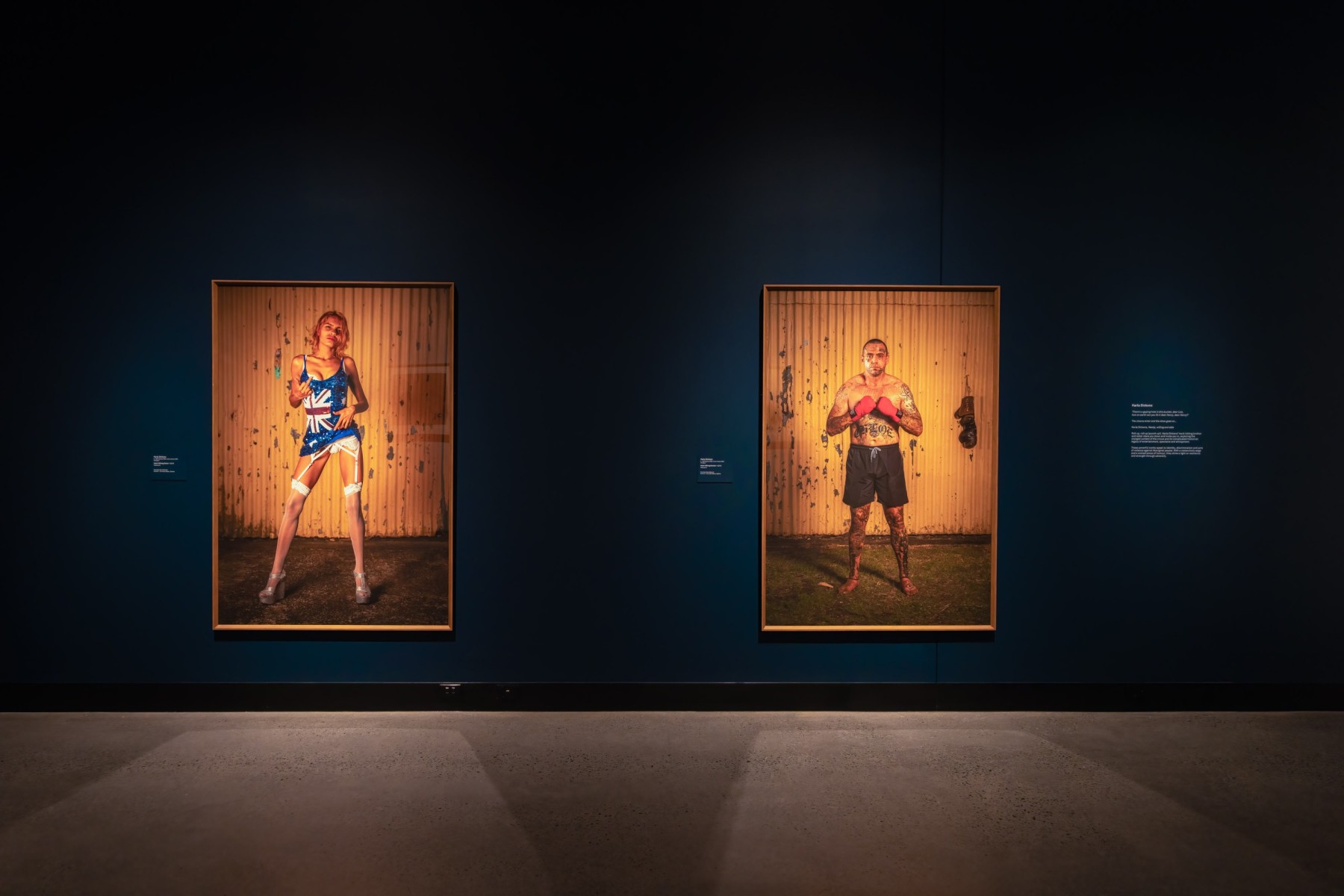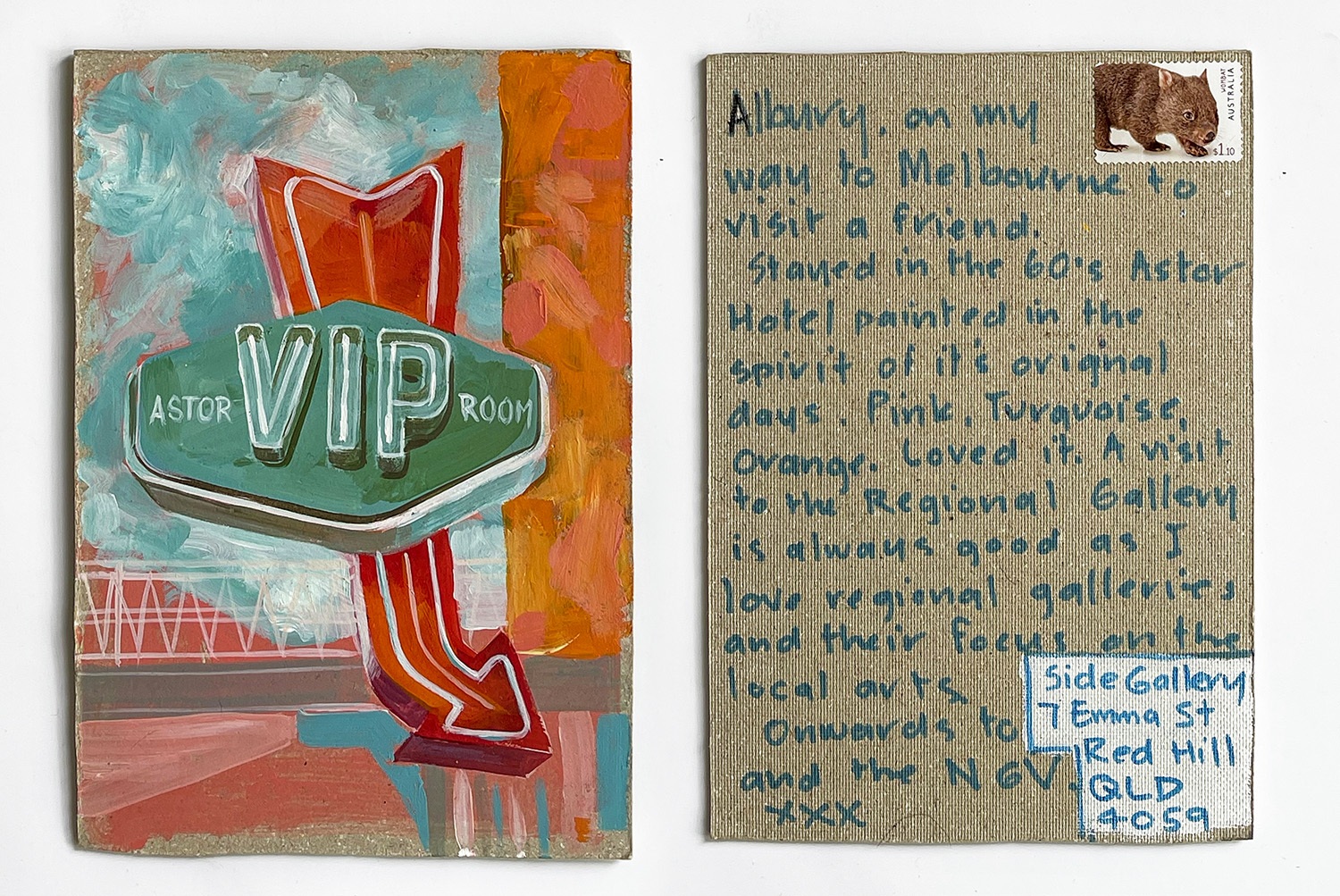Settler-colonialism is not an act of history but an enduring system that continues to shape the oppression of Aboriginal and Torres Strait Islander people today. For First Nations people, the fight for community, culture and Country are ongoing—they continue ‘punching up’ to dismantle structures of power and privilege.
Hosted on the lands of the Kombumerri families of the Yugambeh language region, Punching Up showcases the contemporary photography of Karla Dickens (Wiradjuri), Fiona Foley (Badtjala people, Wondunna clan, K’gari), Michael Cook (Bidjara, North East Region), Tony Albert (Girramay/Yidinji/Kuku Yalanji), Vernon Ah Kee (Kuku Yalandji, Waanji, Yidinji and Gugu Yimithirr people) and Naomi Hobson (Kaantju/Umpila). These leading Indigenous Australian artists have taken control of the lens and subverted traditionally Western photographic practices. Curated by Sam Creyton and Jo-Anne Driessens, the provocative artworks—predominantly drawn from the HOTA collection—create a rich exhibition, illuminating Indigenous resilience through collective strength.
Stepping into the dimly-lit gallery space feels like entering the metaphorical boxing ring; audiences are invited to engage in the fight for justice and recognition, spurred on by the prophetic insights of heavy-weight champions. The exhibition is segmented into three themes, each bound by partition gallery walls, transitioning from an exploration of First Nations lived-experiences into a critique of the monolithic representation of Aboriginal people.
First, we come face-to-face with Karla Dickens’ Hard-Hitting Brother 1 and Hard-Hitting Sister 1 (2019). The unapologetically stern expressions of these two towering figures challenge representations of otherness and notions of the spectacle. Through symbols of star-spangled sequins and tattooed legends, Dickens reflects on the dark histories of human zoos and the acts of violence committed against Aboriginal people. These striking portraits stand firm and reclaim their sacred space.
Fiona Foley’s cinematic photography in The Oyster Fisherman (2011) and Black Velvet (2015) builds on the historical retellings in Dickens’ work to voice the haunting and tragic stories of colonial violence against Aboriginal women. The Oyster Fisherman recounts the abduction and mistreatment of women by fishermen on K’gari throughout the colonial period across four sepia-toned vignettes. Black Velvet captures an ephemeral text-based installation, wherein Foley uses clothing to spell out the titular words, referencing the treatment of Aboriginal women. Across both of these works, Foley gives rise to lesser-told and all-too-often horrifyingly graphic narratives of colonisation.
Moving through the exhibition, Michael Cook’s allegorical series, Natures Mortes (Dead Nature), presents a decadence of decay across eight still-life images. Taking form from the Dutch-masters, these contemporary vanitas mourn the perishing of First Nations knowledge systems, cultural practices, and native flora and fauna. Each tableau focuses on a different theme; Blackbird speaks to the practice of slavery at the heart of the Australian sugar industry, Aliment emphasises the importance of Indigenous foods and medicinal practices. Cook’s skilful use of symbolism deepens the conversation set up by Dickens and Foley, making clear the colonial power structures that still command and inform systems of extraction and violence across Australia.
Turning the corner into the final section of the exhibition, the exhibition shifts thematically to focus on the contemporary representation and perceptions of First Nations peoples.
In Brothers (The Invisible Prodigal Son) 1, 2 & 3 (2020), Tony Albert re-imagines the holy trinity with the images of three Aboriginal boys who protested an instance of police brutality in Kings Cross. The three are depicted with targets on their chests and exalted in the form of stained-glass windows. The work enshrines the brothers as icons of political defiance and resistance, yet maintains the innocence and vulnerability of these young men. This is a narrative that is not reflected in mainstream Australian media.
Across from Albert’s work, Vernon Ah Kee’s wegrewhere (2007-2009) appears almost like postcard images of surfers on the iconic sunny shores of Australia’s golden beaches. The work responds to the 2005 Cronulla riots and critiques the notion of Australian beach culture. Adorned in clichéd beach attire and accompanied by bold culturally-inspired shield surfboards, these photographs humorously challenge existing perceptions of Indigenous peoples in urbanised coastal spaces and reiterate Aboriginal sovereignty.
January First is a documentary photographic series by Naomi Hobson that stretches across the final wall. This series focuses on Auwa, a custom that celebrates new beginnings for the Coen community in North Queensland. These intimate images capture families in their homes and cherished spaces with white clay or flour on their faces as a part of this customary celebration. Like Albert and Ah Kee, Hobson challenges contemporary perceptions of First Nations people in order to reclaim culture as a contemporary practice: one that is alive, shared and thriving amongst community.
Punching Up is an urgent, powerful and deadly exhibition that celebrates leading contemporary Indigenous artists and the dynamic power of their collective voice. It is exciting to see an institution such as HOTA foregrounding contemporary First Nations practices, stories and histories through their collection and acquisitions. Although these artworks have been exhibited in many other contexts, the striking and provocative power of bringing them together in this exhibition creates space to invigorate discussion of colonialism as a persistent contemporary system. Moreover, the exhibition demands that contemporary First Nations’ voices be foregrounded in gallery institutions across Australia.
Georgia Hayward [she/her] is an early-career Meanjin-based artist, curator and artsworker of Maranganji and Scottish descent. Her practice explores the influence of public space on contemporary social dynamics and community development through social, spatial and digital practices, engaging with polyphonic and polycentric readings of public space and cultivating collaborative art-making. Georgia is currently the General Manager of Outer Space, a non-for-profit contemporary arts organisation in Meanjin.









